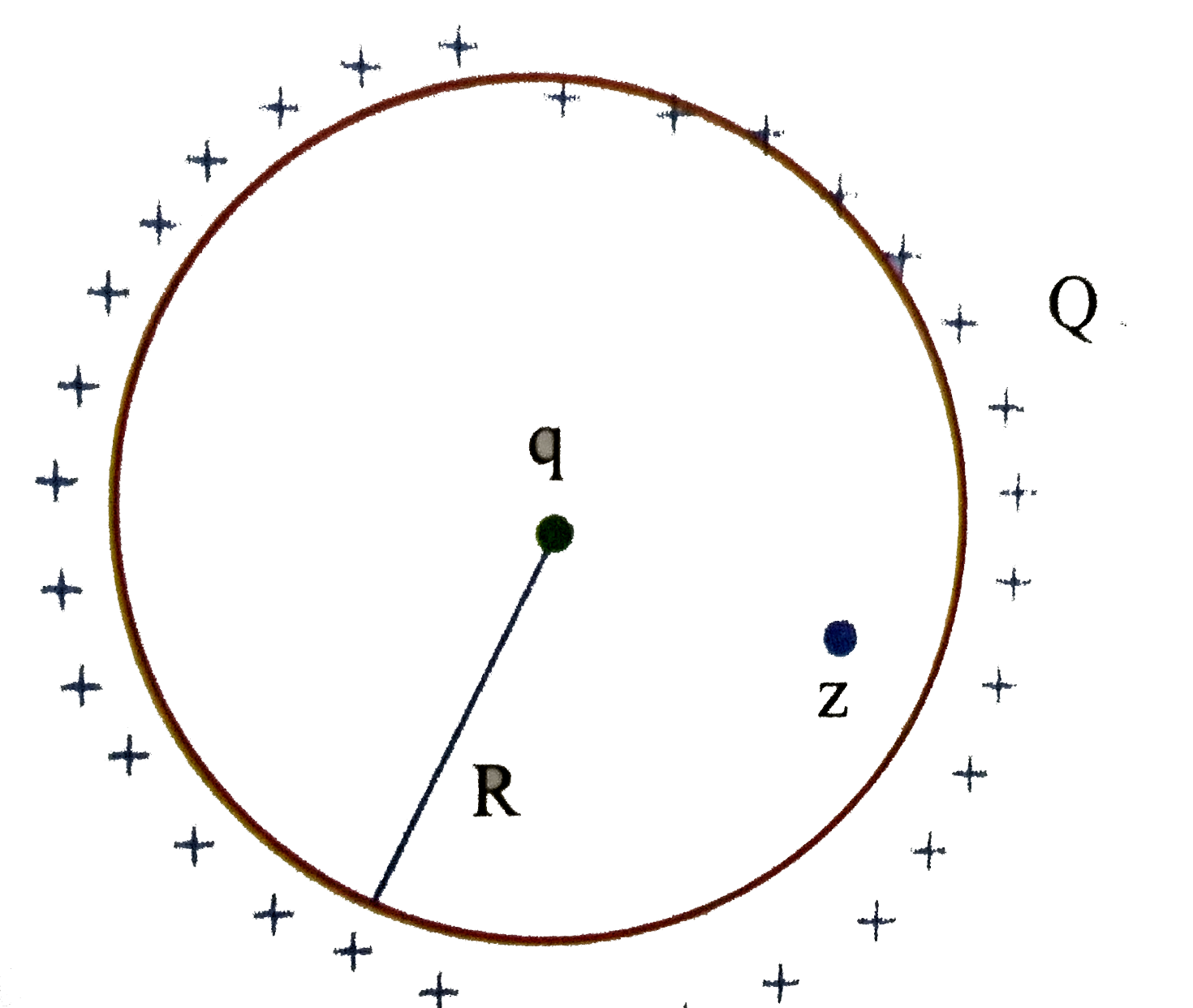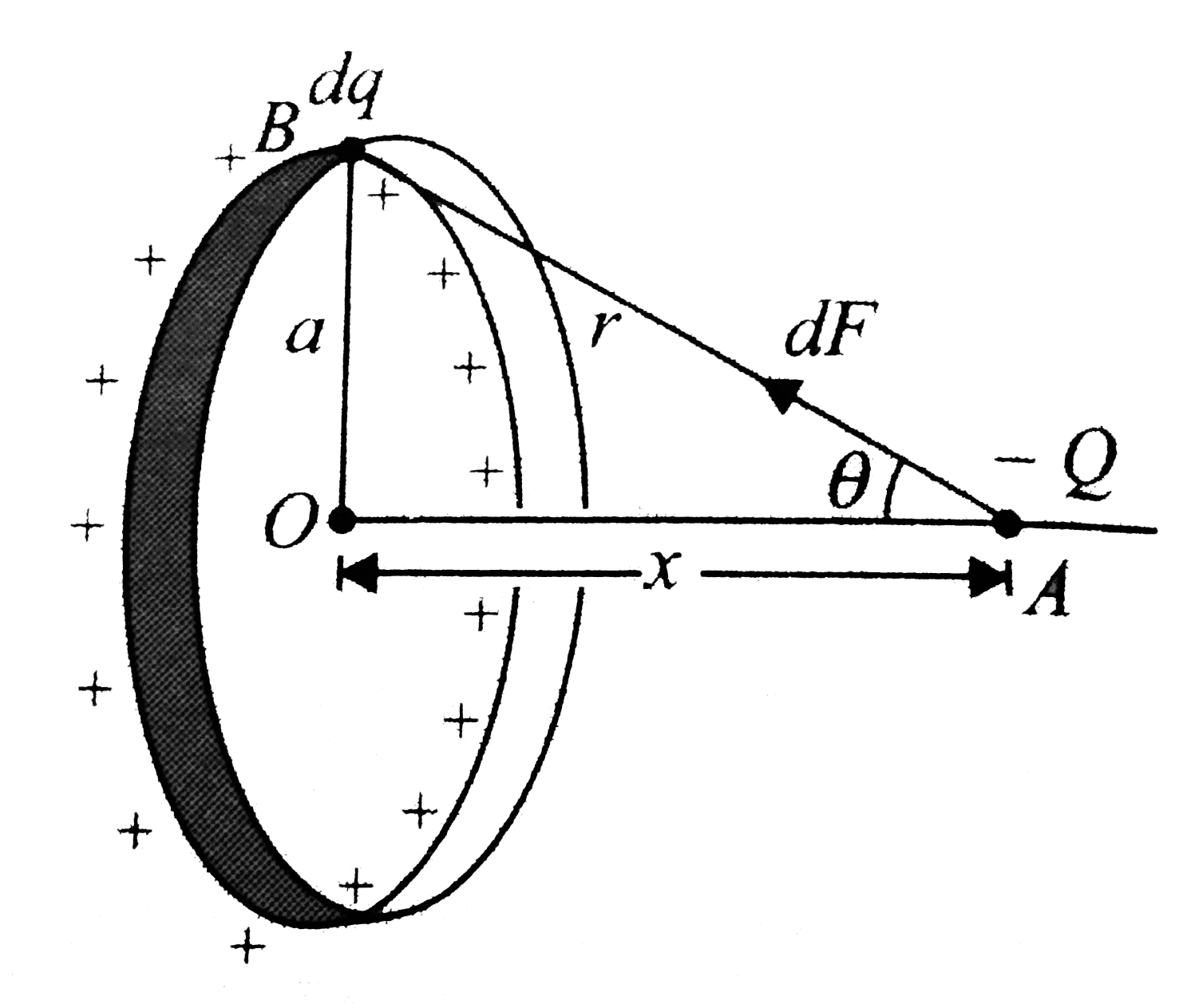Positive charge Q is distributed uniformly over a circular ring of radius R. A particle having a mass m and a negative charge q, is placed on its axis at a distance x from the centre. Find the force on the particle. Assuming x is very less than R, find the time period of oscillation of the particle if it is released from there.
To solve the problem step by step, we will first find the force acting on the particle due to the electric field created by the charged ring, and then we will determine the time period of oscillation for the particle when it is released from a small distance along the axis of the ring.
Step 1: Determine the Electric Field due to the Ring
The electric field E at a distance x from the center of a uniformly charged ring of radius R and total charge Q is given by the formula:
E=kQx(R2+x2)3/2
where k is Coulomb's constant.
Step 2: Calculate the Force on the Particle
The force F on the negative charge −q placed at distance x from the center of the ring can be calculated using the formula:
F=−qE
Substituting the expression for E:
F=−q(kQx(R2+x2)3/2)
Since the charge −q is negative, the force will be directed towards the ring (attractive force):
F=kqQx(R2+x2)3/2
Step 3: Approximation for Small x
Assuming x is very small compared to R (i.e., x≪R), we can simplify the expression for the force. In this case, R2+x2≈R2:
F≈kqQxR3
Step 4: Relate Force to Acceleration
Using Newton's second law, we can relate the force to the acceleration a:
F=ma
Thus, we have:
ma=kqQxR3
This gives us the acceleration:
a=kqQmR3x
Step 5: Identify the Oscillatory Motion
The equation we have resembles the form of simple harmonic motion (SHM):
a=−ω2x
where ω2=kqQmR3.
Step 6: Calculate the Time Period of Oscillation
The time period T of oscillation for a simple harmonic oscillator is given by:
T=2π√1ω2
Substituting for ω2:
T=2π√mR3kqQ
Final Answer
The force on the particle is:
F=kqQx(R2+x2)3/2
And the time period of oscillation when released from a small distance x is:
T=2π√mR3kqQ
---
Topper's Solved these Questions
- ELECTRIC FIELD AND POTENTIALBook:HC VERMA ENGLISHChapter:ELECTRIC FIELD AND POTENTIALExercise:question for short answer
Explore 14 Videos
- ELECTRIC FIELD AND POTENTIALBook:HC VERMA ENGLISHChapter:ELECTRIC FIELD AND POTENTIALExercise:Objective 1
Explore 9 Videos
- ELECTRIC FIELD AND POTENTIALBook:HC VERMA ENGLISHChapter:ELECTRIC FIELD AND POTENTIALExercise:worked out Examples
Explore 19 Videos
- ELECTRIC CURRENT THROUGH GASESBook:HC VERMA ENGLISHChapter:ELECTRIC CURRENT THROUGH GASESExercise:Short answer
Explore 6 Videos
- ELECTROMAGNETIC INDUCTIONBook:HC VERMA ENGLISHChapter:ELECTROMAGNETIC INDUCTIONExercise:Questions for short answer
Explore 9 Videos
Similar Questions
A positive charge Q is uniformly distributed along a circular ring of radius R.a small test charge q is placed at the centre of the ring .The

View SolutionA positive charge Q is uniformly distributed along a circular ring of radius R.a small test charge q is placed at the centre of the ring.

View SolutionA thin fixed ring of radius 'R' and positive charge 'Q' is placed in a vertical plane. A particle of mass 'm' and negative charge 'q' is placed at the centre of ring. If the particle is given a small horizontal displacement, show that it executes SHM. Also find the time period of small oscillations of this particle, about the centre of ring. (Ignore gravity)
View SolutionA thin fixed ring of radius a has a positive chage q unformly distributed over it.A particle of mass m having a megative charge Q, is placed on the axis at a distance of x(x<<a) form the center of the ring. Show that the motion of the negatively chaged particle is approximatly simple harmonic. Calculate the time period of oscillation.

View SolutionElectric charge Q is uniformly distributed around a thin ring of radius a. find the potential a point P on the axis of the ring at a distance x from the centre of the ring .

View SolutionElectric charge Q is uniformly distributed around a thin ring of radius a. find the potential a point P on the axis of the ring at a distance x from the centre of the ring .

View SolutionA long straight wire carries a charge with linear density λ. A particle of mass m and a charge q is released at a distance r from the the wire. The speed of the particle as it crosses a point distance 2r is
View SolutionA charge q0 is distributed uniformly on a ring of radius R. A sphere of equal radius R constructed with its centre on the circumference of the ring. Find the electric flux through the surface of the sphere.
View SolutionA particle of mass m and charge −Q is constrained to move along the axis of a ring of radius a. The ring carries a uniform charge density +λ along its length. Initially, the particle is in the centre of the ring where the force on it is zero. Show that the period of oscillation of the particle when it is displaced slightly from its equilibrium position is given by
T=2πsq√2ε0ma2λQ
View SolutionCharge q is uniformly distributed over a thin half ring of radius R. The electric field at the centre of the ring is
View Solution

